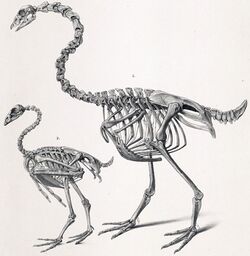Biology:New Zealand goose
| New Zealand geese | |
|---|---|

| |
| Skeletons of the South Island goose and Cape Barren goose | |
| Scientific classification | |
| Domain: | Eukaryota |
| Kingdom: | Animalia |
| Phylum: | Chordata |
| Class: | Aves |
| Order: | Anseriformes |
| Family: | Anatidae |
| Subfamily: | Anserinae |
| Genus: | †Cnemiornis Owen 1866 |
| Species | |
| |
The New Zealand goose is a bird of the extinct genus Cnemiornis of the family Anatidae, subfamily Anserinae.[3] The genus, endemic to New Zealand, consisted of two species: the North Island goose, C. gracilis and the South Island goose C. calcitrans.[4][5]
Description
This goose was as large as some small moa.[6][7] The North Island species had 15 kg (33 lb) in body mass while the South Island species reached 18 kg (40 lb), far surpassing Canada and Cape barren geese.[6] They were flightless,[6] with much-reduced webbing on the feet, an adaptation for terrestrial dwelling similar to that of the nene of Hawaii. They are usually considered most closely related to the Cape Barren goose of Australia .[5]
Extinction
They were never particularly common, and like many other large New Zealand endemic species they were subject to hunting pressures from the settling Polynesians, as well as predation upon their eggs and hatchlings by kiore, or the Polynesian rat (which accompanied the settlers) and the settlers' dogs, and were extinct before the arrival of European settlers.[5][8][6] The Māori name of the North Island goose (C. gracilis) was "tarepo".[1]
References
- ↑ 1.0 1.1 "Cnemiornis gracilis. NZTCS". https://nztcs.org.nz/assessments/119028.
- ↑ "Cnemiornis calcitrans. NZTCS". https://nztcs.org.nz/assessments/119019.
- ↑ Baker, A. J. (1991). "A review of New Zealand ornithology.". Current Ornithology 8: 1–67. ISBN 9780306436406. https://books.google.com/books?id=DvQE-mpLCzwC&pg=PA8.
- ↑ "Cnemiornis Owen". Manaaki Whenua Landcare Research. http://www.nzor.org.nz/names/ad7af65f-b843-4372-8aa1-7064b08169d8.
- ↑ 5.0 5.1 5.2 Worthy, T. H.; Holdaway, R. N.; Sorenson, M. D.; Cooper, A. C. (December 1997). "Description of the first complete skeleton of the extinct New Zealand goose Cnemiornis calcitrans (Aves: Anatidae), and a reassessment of the relationships of Cnemiornis" (in en). Journal of Zoology 243 (4): 695–718. doi:10.1111/j.1469-7998.1997.tb01971.x. https://deepblue.lib.umich.edu/bitstream/handle/2027.42/74169/j.1469-7998.1997.tb01971.x.pdf?sequence=1&isAllowed=y.
- ↑ 6.0 6.1 6.2 6.3 T. H. Worthy, Richard N. Holdaway (2002). The Lost World of the Moa. Prehistoric Life of New Zealand. Indiana University Press. p. 232. ISBN 9780253340344. https://books.google.com/books?id=NtVV7ZSlsY4C&dq=goose+Cnemiornis+kg&pg=PA233-IA3. Retrieved 1 October 2022.
- ↑ Tennyson, Alan J. D. (2006). Extinct birds of New Zealand. Paul Martinson. Wellington, N.Z.: Te Papa Press. pp. 42. ISBN 978-0-909010-21-8. OCLC 80016906. https://www.worldcat.org/oclc/80016906.
- ↑ "Extinct birds". TerraNature Trust. http://www.terranature.org/extinctBirds.htm.
External links
- North Island Goose. Cnemiornis gracilis. by Paul Martinson. Artwork produced for the book Extinct Birds of New Zealand, by Alan Tennyson, Te Papa Press, Wellington, 2006
- South Island Goose. Cnemiornis calcitrans. by Paul Martinson. Artwork produced for the book Extinct Birds of New Zealand, by Alan Tennyson, Te Papa Press, Wellington, 2006
- Recreation of the New Zealand goose vocalisation Morning Report 10 May 2019 Radio New Zealand.
Wikidata ☰ Q3443727 entry
 |



